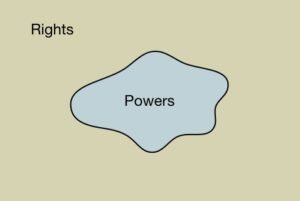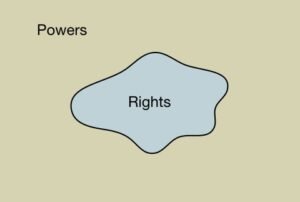The Cardinal Choice
There are two ways of looking at the relationship between the rights of individuals, and the powers of government. The first, which is based on the ideas of the Declaration of Independence, is that people have the right to do pretty much anything, except when they delegate specific powers to government for the purpose of protecting those rights:
We might call the first view ‘Rights minus Powers’, or R-P for short.
The second, which has been steadily gaining traction, is nearly the opposite — government has the power to do pretty much anything, for pretty much any reason, except when that would violate some specific rights:
We might call the second view ‘Powers minus Rights’, or P-R for short.
To get a feel for the difference, consider the 4th Amendment. Under R-P, it means
We can’t search you, unless we can cite some specific delegated power.
Under P-R, it means
We can search you, unless you can cite some specific exemption in the form of a court-recognized right.
Note that the text of the 4th Amendment does create a specific delegated power: The government can search you if there is a warrant, supported by probable cause, and describing the specifics of the search. So under R-P, if there’s no warrant, there’s no search.
In practice, however, the government assumes P-R, grudgingly admitting that you have an ‘expectation of privacy’ which sometimes allows you to refuse to be searched, but increasingly often does not. So under P-R, a warrant is more of a suggestion than a requirement.
Contrast this with the 2nd Amendment, which creates no such delegated power. Under R-P, it means
We can’t prevent you from keeping or bearing arms, period.
Under P-R, it means
We can prevent you from keeping arms that we haven’t approved, and bearing them in situations that we haven’t approved.
In each case, the idea is that what is not permitted is forbidden. What differs is who is giving permission to whom. Under R-P, it’s individuals giving permission to government. But under P-R, it’s government giving permission to individuals.
That is, under R-P, rights are absolute, unless qualifications have been specified (as in the 1st, 3rd, and 4th Amendments). But under P-R, powers are absolute, unless specific exemptions have been approved.
These two views could hardly be more different, or have more influence on whether government moves towards or away from liberty.
I say ‘moves’ because over time, whatever is on the outside eventually crushes what’s on the inside. This is because everything on the inside is effectively an obstacle to be overcome.
In P-R, rights are seen as obstacles to ‘progress’, while in R-P, government powers are seen as obstacles to the enjoyment of ‘the right to be let alone’, which Justice Brandeis called ‘the most comprehensive of rights, and the right most valued by civilized men’.
In R-P, rights expand and powers shrink as the natural result of using improvements in knowledge and technology to relieve government of powers that it may once have needed, but no longer does.
In P-R, powers expand and rights shrink as the natural result of creating new exceptions, new entitlements, new emergency powers, new licensing requirements, and so on, all of which whittle away at the rights of individuals to control their own lives.
In short, the diagram for P-R is a picture of government by majority rule — where the Karenocracy™️ constantly looks for new ways to expand government power at the expense of individual rights, and people welcome this as a way of fleeing responsibility.
In other words, a world of children, with government as the parents.
In contrast, the diagram for R-P is a picture of government by consent — where individuals make their own decisions, reap the benefits when that works out, accept the consequences when it doesn’t, ask for help when they need it, and offer help where they think it’s appropriate.
In other words, a world of adults, with governments mainly providing peaceful alternatives to feuds and duels.
Of all the choices that we can make as a society, the choice between R-P and P-R is the cardinal choice, the one that determines, in the long run, whether rights eventually obviate powers, or powers eventually crush rights.
And it’s a choice that we have to keep making, over and over again. But to make the choice, we first have to be aware of the choice — between expansive rights limited by delegated powers, or expansive powers limited by approved rights.


